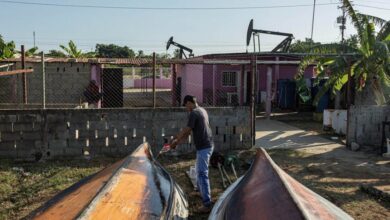Remittances Surge to Record Highs in Central America’s Northern Triangle

In the first half of 2024, remittances to El Salvador, Guatemala, and Honduras, known as the Northern Triangle of Central America, rose by 4.2%, reaching an unprecedented $18.95 billion. This highlights the critical role of this migration financial lifeline in the region’s economies.
The economies of El Salvador, Guatemala, and Honduras, collectively known as the Northern Triangle of Central America, have long relied on remittances sent by their citizens working abroad. These financial transfers are a crucial lifeline for many families, providing them the means to survive in a region marked by economic instability and widespread poverty.
In the first half of 2024, these three countries’ remittances grew by 4.2%, reaching an astonishing $18.95 billion, according to data compiled by the International Organization for Migration (IOM). This represents an increase of $765.4 million compared to the $18.19 billion received during the same period in 2023. The rise in remittances underscores their vital importance to the Northern Triangle’s economy, where they play a central role in supporting household consumption and local businesses.
El Salvador, Guatemala, and Honduras are among the poorest countries in Latin America, with millions of their citizens living in extreme poverty. In this context, remittances often distinguish between having enough to eat and going hungry. They cover basic needs such as food, healthcare, and education and are a critical source of income for many families who would otherwise have little or no financial support.
Year-on-Year Growth Despite Economic Challenges
The growth in remittances to the Northern Triangle in 2024 is particularly noteworthy given the economic challenges both the sending and receiving countries face. The global economic slowdown, rising inflation, and economic instability in the United States, where most of these remittances originate, have not deterred funds back to Central America.
The region has seen a consistent year-on-year increase in remittances over the past few years. In 2023, the Northern Triangle received $37.16 billion in remittances, up from $34.48 billion in 2022, representing a 7.8% increase. This trend highlights the resilience of remittance flows even in the face of global economic uncertainty.
Breaking down the figures, Guatemala received the largest share of remittances in the first half of 2024, with $10.27 billion, followed by Honduras with $4.63 billion, and El Salvador with $4.05 billion. These numbers reflect the size of the migrant populations from each country living abroad, particularly in the United States, where most of these funds originate.
The Impact of Migration on Remittance Flows
Migration is a significant factor driving the flow of remittances to the Northern Triangle. Each year, more than 500,000 people from El Salvador, Guatemala, and Honduras attempt to migrate to the United States, often risking their lives in the process. They flee from violence, poverty, and lack of opportunities in their home countries, seeking better prospects for themselves and their families.
Once they reach the United States, many migrants work in low-wage jobs and send a portion of their earnings back home to support their families. For many households in the Northern Triangle, these remittances are a vital source of income that helps them make ends meet in a region where jobs are scarce and wages are low.
However, the reliance on remittances also comes with risks. The economic well-being of families in the Northern Triangle is closely tied to the fortunes of their relatives working abroad. Any downturn in the U.S. economy, changes in immigration policies, or increased deportations could devastate the flow of remittances and, consequently, the livelihoods of those who depend on them.
The Growing Dependence on Remittances in El Salvador
El Salvador, in particular, has become increasingly dependent on remittances, now a cornerstone of the country’s economy. It is estimated that more than 2 million Salvadorans live in the United States and send billions of dollars back home each year. In 2024 alone, El Salvador received over $4 billion in remittances during the first six months.
According to various economists, this money is predominantly used to consume services, including healthcare, education, and housing. The high reliance on remittances has helped stabilize the Salvadoran economy but also raises concerns about the country’s long-term economic sustainability. With so much of the economy dependent on funds sent from abroad, El Salvador is vulnerable to external shocks that could disrupt the flow of remittances.
The Salvadoran government has recognized the importance of remittances and has taken steps to facilitate sending and receiving money. However, much work remains to create more opportunities for economic growth within the country so that future generations do not have to rely on migration and remittances for survival.
As the Northern Triangle grapples with economic challenges, violence, and political instability, the importance of remittances will only grow. These funds provide a lifeline for millions of people. Still, they also highlight the need for broader economic reforms and investment in the region to create a more sustainable and self-sufficient future.
Also read: Youth Unemployment Declines in Latin America Amid Challenges
The steady increase in remittances to El Salvador, Guatemala, and Honduras underscores their critical role in the region’s economies. However, it also raises questions about the long-term viability of an economic model that relies so heavily on money sent from abroad. For the Northern Triangle to achieve lasting prosperity, it must find ways to create opportunities at home, reducing the need for its citizens to seek a better life elsewhere.




